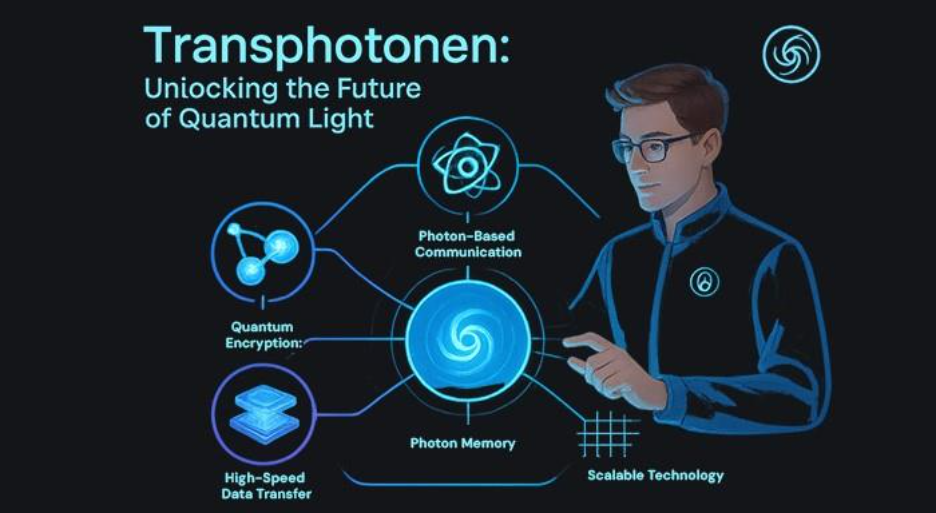Transphotonen is transforming the science of light using the inherent quirk of photons in the quantum world. It is not merely a matter of playing with light in this latest
Transphotonen is transforming the science of light using the inherent quirk of photons in the quantum world. It is not merely a matter of playing with light in this latest version of photonics, but it has high data transfer rates, secure communication, and enhanced quantum control. This technology will transform various industries like computing, medicine, defense, and telecom.
This utilizes quantum phenomena like entanglement, superposition, and coherence to make solutions previously impossible. Through the illumination of light as a method of making change, this innovation in technology has the potential to revolutionize the future of technology, communication, and scientific inquiry across the globe.
What is Transphotonen?
"Transphotonen" combines the Latin "trans-," meaning beyond, and the German "photonen," referring to photons. It indicates new pathways for control over photons that exceed conventional optical data transfer approaches. Unlike conventional approaches, Transphotonen stresses the use of bizarre properties of light at the quantum level, such as photon entanglement and superposition.
Fundamentally, Transphotonen is about creating new systems that drive quantum technologies into everyday use. Applications vary from secure quantum communication to building the quantum internet and creating an ecosystem where light enables unbreakable encryption and fast connectivity. The idea remains in experimental phases, but it's caught broad attention among global research centers.
Key Features of Transphotonen

- Photon-Based Communication: Employs entangled photons for instantaneous and secure data transfer.
- Quantum Encryption: Offers unbreakable encryption by sensing any attempt at eavesdropping.
- Photon Memory: Remembers quantum states of photons for precise retrieval and processing.
- High-Speed Data Transfer: Delivers speeds much higher than conventional photonics.
- Scalable Technology: Amenable to integration into networks, computer systems, and medical equipment.
Exploring the Science Behind Transphotonen
Photonics has revolutionized industries by speeding up data transfer, high-resolution imaging, and laser technology, to mention but a few. Transphotonen aims at further pushing the developments by coming up with additional methods on the manipulation and integration of light.
- Basic principles of the study are: The generation of technologically sophisticated light conditions: Besides laser beams, quantum sources of light, photon entanglements, and tunable frequencies of light are being investigated by scientists.
- Nanoscale manipulation: With nanophotonics, it is possible to manipulate single photons within periods shorter than a light's wavelength; hence, computation and measurement are deterministic.
- Ultra-sensitive detection: Single photon registering detectors and other deviations of light properties are constructed. They open the door to never-before-heard-of scientific and medical devices by virtue of having immensely sophisticated technology.
- The primary task of Transphotonen is to expand photonics horizons and scientific research protocols, which were until now being left aside.
Transphotonen Differs from Traditional Photonics
| Feature | Traditional Photonics | Transphotonen |
|---|---|---|
| Data Transmission | Classical light properties | Quantum-level photon manipulation |
| Security | Basic encryption | Quantum encryption with entanglement |
| Speed | Moderate | Ultra-fast optical data transfer |
| Precision | Standard | High precision using photon coherence and memory |
Transphotonen is changing the optical business by applying quantum repeaters and entanglement-based communication to circumvent classical constraints.
The Importance of Transphotonen
Transphotonen is transdisciplinary, and its importance cannot be doubted. As electricity constructed the 19th century and computational computing constructed the 20th century, light science is sure to be at the forefront of the 21st century.
Transphotonen combines theoretical and practical innovation in information science, physics, and engineering. Impacts range from the medical industry to the cybersecurity sector, and its influence on the everyday lives of people is yet to be predicted.
Challenges and Limitations
- Photon Memory Instability: The quantum states are delicate and impossible to maintain in the long run, and this can affect data accuracy and system integrity.
- High Infrastructure Costs: It is based on high-level optical systems, precision tools, and specialized coolers, and thus it is expensive to implement at a large scale.
- Developmental stage: The technology is still being developed and calls for high precision, which presently limits any mass applications.
- Need for standards: Standardized global protocols are required for seamless integration across industries and validated performance.
- Environmental sensitivity: The coherence of the photons can be disrupted by a change in temperature, electromagnetic interference, or other environmental factors affecting its effectiveness.
Future Applications and Advances in Transphotonen
As researchers work to enhance the field, enormous frontiers of possibility emerge:
- Photon Internet: With cutting-edge fiber and satellite networks to support hypersonic worldwide connectivity.
- Smart City Light Networks: Light-dependent communications, monitoring, and alert systems for the exchange of files.
- Bio-Photonics: Employing light while studying microscale biological phenomena.
- Transdisciplinary Research: Working with artists, engineers, and scientists to study light in laboratories but also outside of them.
Transphotonen is not science but a recasting of human creative capabilities in terms of light.
Conclusion
Transphotonics is a groundbreaking development in light science that incorporates the quantum properties of photons to rethink computing, communications, medical care, and defense. It fundamentally moves beyond traditional photonics by enabling ultra-fast data exchanges, secure quantum communications, and precise control of photons.
This intersection of physics, engineering, and information science will provide applications from quantum internet to imaging far beyond present-day medicine. In spite of difficulties like photon memory stability and costly infrastructure, research and global involvement are ongoing to seek a path toward implementation. Transphoton is close to becoming a lynchpin of 21st-century
technology and shaping the future of innovation for decades to come.
FAQs for Transphotonen
Q. What is transphotonen?
A. Advanced technology in quantum photonics that supports safe and fast transmission of data through photons.
Q: How is it different from conventional photonics?
A. Works on quantum properties such as entanglement and coherence rather than using classical light techniques.
Q, What are the most important applications of Transphotonen?
A. Quantum internet, medical imaging, defense, and photon-based computing.
Q. What are the important issues?
A. Photon memory stability, cost of infrastructure, global standardization, and precision of the technology.
Q. Why is this important?
A. Supporting advances in secure communication, computing, healthcare, and research in photonics.
Respond to this article with emojis






